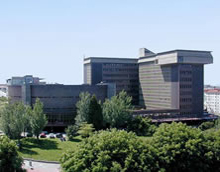Asturias
The Unit of Molecular Epidemiology of the University Institute of Oncology of the University of Oviedo initiated in 2004 in Asturias one cohort of new born children, at the 12th week of pregnancy, of the population of Sanitary Area III. The objective was to study the paper of the environmental exposures in the children’s development (neurobehavioural and anthropometric) and health (mainly respiratory), in the frame of the INMA (Childhood and Environment) network, a project financed by the Institute of Health Carlos III. It is an observational study of cohorts that follows pregnant women of the general population from the first trimester to the childbirth and their children from the birth to the adolescence. The women had to be resident in Area III of Asturias, with age equal or over 16 years, and they were recruited between 2004 and 2006. Other criteria of inclusion were: unique pregnancy, no problems for a fluent communication, and not to suffer any chronic disease.
The Sanitary area III of Asturias includes the councils of Avilés, Corvera, Castrillón, Gozón, Cudillero, Pravia, Paredes de Nalón, and Soto del Barco, with their primary attention centre in the Hospital San Agustín de Avilés. The area is particular because of a high level of industrialisation that has offered a good opportunity to create one cohort from the pregnancy: the size of population allowed to recruit in 2 years the number of required pregnant women; the integration of its sanitary structure enabled that all the pregnant women attended the same centre of secondary attention for the first visit and echography a and an only hospital for the childbirth.
The recruited cohort presents characteristics common of the pregnancies in our surroundings (average age 31.82 years, occupation during the pregnancy 70.51%, smoking in the third trimester of pregnancy 17.76%), although the participants had a certain selection towards one better education and social support that the average: education superior to the primary one 81.85%, biparental family at the birth of the child 99.38%. Nevertheless the variability in the exposures, both contamination and diet, assures that it is a contextual frame of great value for the proposed study.
Collected data includes individual exposure to atmospheric contamination during pregnancy, intrauterine and post-birth growth, mental development to the year and a half, and diet and nutrients during the pregnancy and to the year and a half of age. Blood of the mother, cord blood and maternal milk were also taken. The pursuit to the 18 months of age is being completed, with an answer of 92%.
-
Entidades Colaboradoras:




